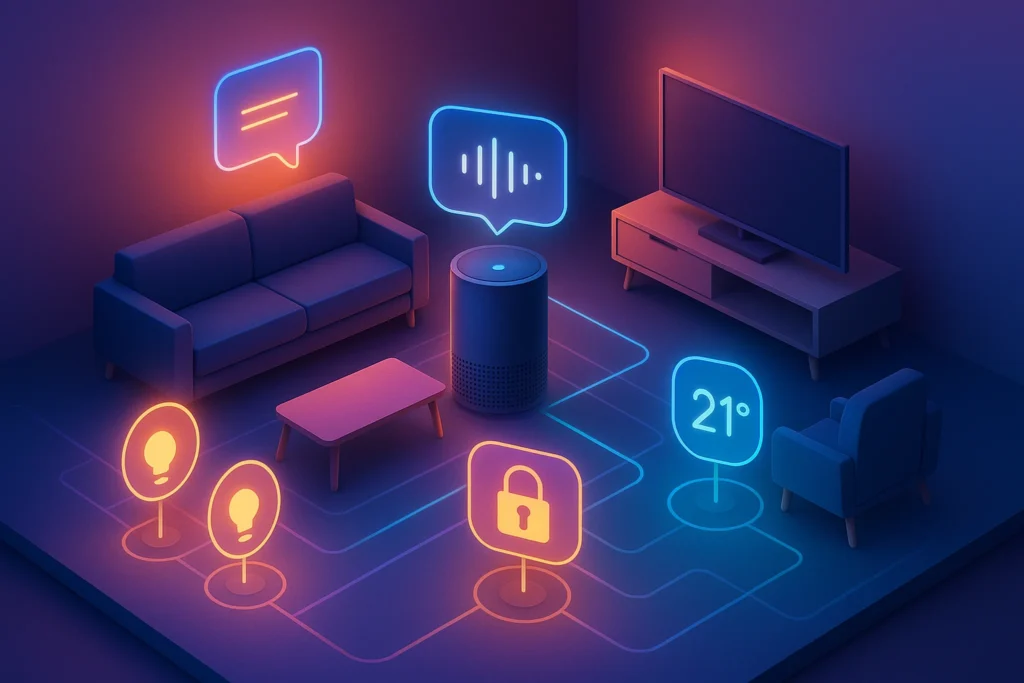-This post may contain affiliate links. If you click on one and make a purchase, I may earn a small commission at no extra cost to you.-
🧠 1. Why Build a Smart Home in 2025?
Smart homes now offer more than voice commands—they learn, anticipate needs, and help you live better. In 2025, the focus is on:
-
Wellness-focused automation like circadian lighting and air quality sensors
-
Invisible tech that blends into home design
-
Sustainability & energy savings using solar, smart thermostats, and HVAC zoning
Build a Strong Foundation with Reliable Connectivity
Before adding any smart gadgets, ensure your home’s network is ready. This is the backbone of every automation:
Why it matters:
Smart homes rely on real-time communication. Devices like cameras, thermostats, and sensors constantly send data back to hubs or apps. A slow or patchy network causes lag, disconnections, or failed automations.
How to do it:
Invest in a modern Wi-Fi 6E router with mesh capabilities for larger homes. For mission-critical devices—like security cameras—run Ethernet cables where possible.
If you’re using multiple devices, consider hubs supporting Zigbee or Thread. These low-energy protocols create a mesh network among devices, ensuring fast, local, and stable communication even if the internet goes down.
Your goal: build a smart system that’s secure, expandable, and enhances wellbeing—not just flashy features.
2. Essential Setup Steps — The Foundation
-
Robust Connectivity
-
Use a strong Wi-Fi 6E router or Ethernet backhaul.
-
Zigbee/Z‑Wave mesh is ideal for local device control
-
-
Choose a Control Ecosystem
-
Go with Matter-compatible hubs: Google Nest, Apple HomePod Mini, and Amazon Echo Show
-
Matter 1.4.1 adds NFC setup and multi-device support—meaning smoother future-proofing
-
-
Create Device Networks
-
Group devices by function or room for automation efficiency.
-
Example: “Evening Lights” that activate at sunset.
-
Choose Your Ecosystem & Control Hub Wisely
Not all devices talk to each other. This is where the ecosystem decision comes in—Apple HomeKit, Google Home, or Amazon Alexa.
Why it matters:
Each platform has strengths—Apple excels at privacy, Google is great with automation, and Amazon supports the widest range of devices. The ecosystem you choose determines the app, voice assistant, and compatibility with future devices.
How to do it:
Pick a Matter-compatible hub. Devices like Apple’s HomePod Mini, Google Nest Hub Max, or Echo Show 10 support Matter—the new universal standard ensuring devices work together across brands.
For 2025, Matter support means you’ll avoid compatibility headaches and keep options open as your smart home grows.
3. Top Devices to Start With (Seamless Integration)
a) Smart Lighting
-
Philips Hue (Zigbee) or Wi‑Fi alternatives like Wiz
-
Set circadian scenes, sync lights with media
-
Automate “Good Morning” and “Good Night” modes.
-
b) Smart Thermostat
-
Nest Learning, Ecobee, or Honeywell with Matter support
-
Use room occupancy sensors and temperature schedules for efficiency.
-
c) Security & Cameras
-
Google Nest/Doorbell, Eufy, Ring
-
Integrate with Alexa/Google for one-tap monitoring
-
Install on Ethernet for reliable streaming; add privacy zones.
-
d) Smart Plugs & Outlets
-
TP-Link Kasa, Matter-compatible smart outlets
-
Automate startup gadgets, lamps, routers, and appliances.
-
e) Voice Assistants & Hubs
-
Echo Show 8/15, Nest Hub, HomePod Mini
-
Control, visuals, home intercom, calendar sync.
-
Start with Core Devices (Lighting, Thermostats, Security)
Jumping straight into dozens of smart gadgets is overwhelming. Instead, begin with essential categories that immediately boost comfort and efficiency.
Lighting – Example: Philips Hue or Wiz
Use case:
Set mood lighting for mornings, work sessions, and movie nights. Use motion sensors to automatically turn on hallway lights after dark.
Why it works:
Lighting impacts your mood and sleep. Smart lights let you schedule brightness, color temperature, and even integrate with sunrise/sunset cycles.
Thermostats – Example: Ecobee SmartThermostat
Use case:
Create zones for each room. Automatically lower temperature when everyone leaves. Boost heating just before you wake up.
Why it works:
Heating/cooling is a major energy cost. Smart thermostats save money and increase comfort by learning your habits.
Security Cameras & Sensors – Example: Google Nest Cam
Use case:
Get instant alerts when movement is detected at the door, even when you’re not home. Use facial recognition to reduce false alarms.
Why it works:
Smart security adds peace of mind. Integration with voice assistants means you can check your camera feed with a simple voice command.
4. Advanced Device Add-ons
-
Smart Blinds/Shades – Hide tech, blend design
-
Air Quality + Wellness Sensors – Detect VOCs, humidity levels, CO₂.
-
Water Leak Detectors & Smart Shutoff – Prevent damage.
-
Robot Vacuum with Wi-Fi/AI – Automate cleaning, coordinate with inactivity schedules—but isolate from other switches for security
Add Smart Plugs & Voice Control for Daily Automation
Smart Plugs – Example: TP-Link Kasa Smart Plug
Use case:
Turn on your coffee maker every morning at 7 a.m. Or cut off power to the TV after bedtime.
Why it works:
They make any dumb device smart. They’re affordable, easy to install, and ideal for experimenting with automation.
Voice Control – Example: Google Nest Hub or Amazon Echo Show
Use case:
“Turn off all lights.” “What’s the indoor temperature?” “Play bedtime music.”
Why it works:
Smart homes should feel intuitive. Voice assistants reduce friction and make control accessible for everyone in the home.
5. Setting Up Automations & Routines
-
Sunset/Wake-Up Routines – Sync lights and blinds for wellness .
-
Away Mode – Lower thermostat, arm security, turn off nonessential devices.
-
Presence-Based Actions – Doors lock when your phone leaves home network.
-
Seasonal Adjustments – Preheat shower water via geothermal sensors.
Automate Routines Based on Presence & Time
With foundational devices set up, begin layering smart routines:
Example routine:
When your phone leaves the house, the system locks doors, turns off lights, lowers thermostat, and sends you a status update.
Why it matters:
Automation makes your home proactive—not reactive. You save time, energy, and never have to remember to double-check things before leaving.
Advanced ideas:
-
Use sunrise triggers to gradually brighten lights.
-
Add motion sensors to adjust lighting based on activity.
-
Control your robot vacuum to only clean when you’re at work.
6. Security Essentials — Protect Your Smart Network
-
Isolate smart devices on a separate VLAN/guest Wi-Fi
-
Change default passwords and enable 2FA on hubs and apps.
-
Regularly check firmware; disable unused cloud services.
-
For advanced setups, consider network intrusion detection like Suricata
7. Troubleshooting Common Issues
-
Device not linking? – Ensure it’s updated and on the correct Zigbee/Thread network.
-
Automation fails? – Routines may conflict—use tool logs or smart-home apps to test triggers step-by-step.
-
Slow Wi-Fi? – Run speed test near each device and install mesh extenders; Zigbee is less prone to dropouts.
8. Planning for the Future
-
Adopt Matter-compatible devices; updates are widely available
-
Expand into AI energy tools, such as solar-integrated storage and smart grid features
-
Keep scalability in mind—start small, plan ahead with cable or hub placements for future expansions .
❓ Frequently Asked Questions
Q1: Can I build a smart home on a budget?
→ Yes—start with essentials like smart plugs, bulbs, and voice hubs under $50 each
Q2: Is Wi-Fi enough, or do I need Zigbee/Z‑Wave?
→ Wi‑Fi works, but mesh systems (Zigbee/Z‑Wave/Thread) are more reliable and energy efficient for large scale.
Q3: Are smart vacuums secure?
→ Avoid integrated cameras unless isolated on separate networks—these devices have common vulnerabilities
Q4: What’s Matter, and why does it matter?
→ It’s a universal connectivity standard backed by Apple, Google, Amazon—ensuring devices from different brands work together seamlessly
Q5: How do I start small and scale?
→ Begin with lighting and plugs; build confidence with automation. Add security and HVAC features once familiar.
💬 Would You Bite?
What’s the one smart home upgrade you’re most excited about—voice control, security automation, or energy savings?
Drop your top pick below, and I’ll send setup scripts tailored to it!👇



